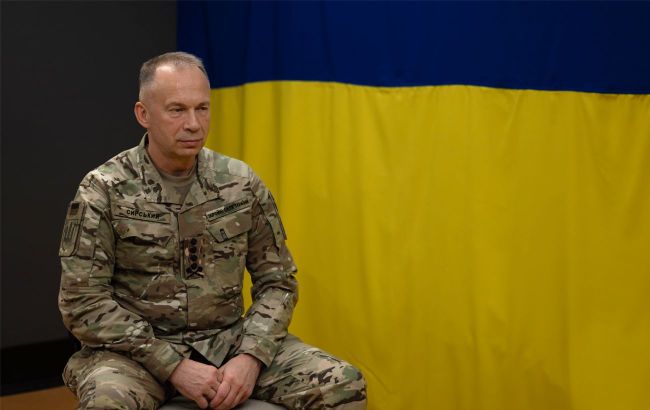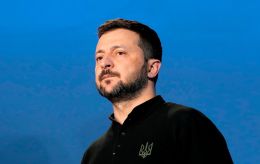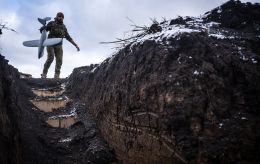Ukraine must constantly prepare for war with Russia: Interview with army chief Syrskyi
 Commander-in-Chief of the Armed Forces of Ukraine General Oleksandr Syrskyi (all photos: Main Directorate of Communications of the Armed Forces of Ukraine)
Commander-in-Chief of the Armed Forces of Ukraine General Oleksandr Syrskyi (all photos: Main Directorate of Communications of the Armed Forces of Ukraine)
In a profound interview with RBC-Ukraine, Commander-in-Chief of the Armed Forces of Ukraine General Oleksandr Syrskyi assesses the risks of new Russian offensives, shares changes in the Ukrainian army, and explains why we must always be prepared for war - its continuation or the start of a new one - even despite possible security guarantees and the negotiation process.
General Oleksandr Syrskyi commanded the defense of Kyiv and the counteroffensive in the Kharkiv region in 2022, an operation that resulted in the liberation of significant territories of Ukraine. At that point, he already had eight years of war and resistance to Russian aggression in the east behind him.
In early 2024, he took command of the Armed Forces during one of the most difficult periods of the war: the Ukrainian army was forced to switch to defense, while the Russians intensified their strategic offensive operation to capture the entire Donetsk region, advance in the Kharkiv region, and later in the Zaporizhzhia, Kherson, and Sumy regions.
Here is the abridged version of the conversation with the Commander-in-Chief, highlighting the key points.
Russia's plans on the frontline
The situation at the front is indeed difficult. Russia continues its strategic offensive operation. As General Syrskyi explains, the enemy is now regrouping and concentrating on two main directions.
"The first is the Pokrovsk direction, which remains decisive for the Russians. And now the enemy is redeploying its units from the Sumy sector to the Zaporizhzhia sector. This means the second direction where the enemy plans to launch active offensive actions. As of today, the fighting there (in the Zaporizhzhia sector – ed.) is of low intensity. But in carrying out Putin's goals and orders, the occupiers are also trying to deliver a powerful strike there – one that had been planned as far back as last year,” the General explained.
He noted that this plan was disrupted by the Kursk operation, since to contain Ukraine's advance there, the enemy was forced to withdraw most of its forces from the Zaporizhzhia region. The current objective of Russians in Zaporizhzhia is to break through Ukraine's defenses and advance deeper into the territory – their target is the entire region.
Syrskyi also suggested that in the near term, the Novopavlivka direction (southern Donetsk region) and the Lyman direction will also be among the enemy’s priorities. The Russians are attempting to gain ground there as well, but those battles are of a smaller scale.

Situation near Pokrovsk and Dobropillia
At present, the Pokrovsk sector is the most difficult part of the front, the Commander-in-Chief said. There are about fifty enemy assault actions recorded there daily. Despite the occupiers' pressure, logistics to Pokrovsk can still be maintained.
The enemy is using the so-called "thousand cuts" tactic – advancing along a broad front with small assault groups, Syrskyi explained.
He admitted that last week the Russians had some success in the Pokrovsk direction, near Dobropillia, when their groups pushed 10–12 km toward several Ukrainian settlements. The Commander-in-Chief explained that this happened because the local terrain is full of ravines and rivers – natural features that allow for concealed movement. In summer, the thick vegetation makes it even harder to control the line of contact.
"And secondly, for objective reasons, we do not have a continuous front line there, so the enemy took advantage of this and advanced. But after some decisive measures were taken – with additional forces and means from our airborne units redeployed – we cleared the settlements and terrain, and the enemy's triumph turned into despair. At first, their posts on social media had a tone of 'forward, victory,' and now it's 'encircled, the end.' In other words, everything came to its logical conclusion," Syrskyi noted.
According to him, this enemy push near Dobropillia is part of their overall offensive against Pokrovsk. The enemy is trying to encircle the Pokrovsk agglomeration from two sides – from the northeast and the southwest – attempting to form a kind of pincer movement.
"The main task of these actions in the northern sector is to cut off our logistics. It is there that the 51st Combined Arms Army of the Russian Federation is advancing with three brigades – the former 1st Army Corps of the so-called DPR (Donetsk People's Republic - ed.). Soldiers of the 132nd Brigade – the Horlivka brigade – have been captured and eliminated. If you saw the prisoners, they were all young servicemen, with different lengths of service, drafted from different places, including Russia. But their fate is the same – captivity," the General said.
Threats to Sumy and Kherson
In the Sumy region, the enemy has suffered defeat, the Commander-in-Chief said. Despite concentrating a powerful grouping of its best units there, Russia has had no success over the past two months. It has realized the futility of its actions in this direction.
"They lost several settlements. Their last attempt to advance in the area of Stepne and Novokostiantynivka ended in complete failure – the invaders were destroyed and pushed back across the state border. Now, we continue offensive actions there. And the enemy, realizing the hopelessness of this direction, is now redeploying units from there to other sectors, mainly Zaporizhzhia," the General explained.
As for Kherson, where the occupiers recently tried with a series of strikes to destroy one of the bridges and effectively isolate one of the city's districts, no offensive actions by the Russians are expected there soon.
"There, the Russians are active mainly in the island zone and near the bridges. At the same time, they have redeployed one regiment and a marine brigade away from this sector, which indicates that there will be no major offensive actions in the near term in the Dnipro area. Although the threat, of course, always exists, and we must not ignore it," Syrskyi said.
Possible war end and the readiness of the Armed Forces for any scenario
When asked whether Ukraine's Armed Forces have the strength to hold on if Putin seeks to prolong the war, the Commander-in-Chief said: We have no other choice – we must defend our land.
"Putin is not so much trying to buy time – he wants to seize territory, and that takes time. Despite their (Russia's - ed.) losses – and their losses are constantly growing – every kilometer, every position they capture costs them more and more dead and wounded. The statistics prove this. First, the pace of their offense has slowed considerably. Second, their casualty levels are very high. Yet they stubbornly continue trying to achieve the goals they have set for themselves," Syrskyi noted.
According to him, regardless of the security guarantees Ukraine may receive in the future or any negotiation process, the country must constantly prepare for war, for its continuation by Russia, or the outbreak of a new one.
"Even in the event of a peace deal or a frozen conflict, we must continually strengthen the combat capability of our army, learn the lessons of this war through detailed analysis, and build the most modern, powerful, high-tech military. I believe the enemy will be able to recover very quickly. So our country must not forget the lessons of this war. We must be ready for the possibility that the war could resume at any time. Because the threat will remain. Because the enemy has not abandoned its intent to capture all of Ukraine," the General said.
He recalled that the enemy used the "May truce" to regroup – bringing up artillery and drone units to the front line, something they could not do when heavy fighting was ongoing. Immediately after that truce, the Russians launched active offensive actions.
At the same time, he does not believe Russian claims that they can continue the war for years, calling such statements "bravado."
Modern weapons, AI and robots at the front
The Ukrainian army is now betting on high-tech weapons and systems that reduce the direct presence of servicemen on the battlefield. According to Syrskyi, this primarily concerns robotic platforms and unmanned systems of various types and purposes — mainly aerial drones. Ground unmanned systems are also being actively introduced — logistical and medical ones for evacuating the wounded.
"We are already testing aerial platforms for medical evacuation — that's the future. Another priority for us is drones that work as interceptors to fight against enemy strike UAVs. And we have many impressive results achieved with our naval platforms. All of this is technological weaponry, weapons with artificial intelligence, so to speak," the Commander-in-Chief said.
He added that virtually all of Ukraine’s advanced weaponry contains elements of artificial intelligence, including air defense systems.
"AI is now actively used almost everywhere. But we have to keep in mind that it can make mistakes. This is only the beginning of its development and use. Still, we have already created structures in the General Staff and other headquarters specifically dedicated to applying artificial intelligence in the military sphere," the General explained.
Recently, Ukraine's 93rd Separate Mechanized Brigade Kholodnyi Yar published a video showing its soldiers clearing settlements near Dobropillia using robots armed with machine guns. These robots approached the enemy at close range and, through loudspeakers, offered Russian troops the chance to surrender. If they refused, the robots opened fire. According to Syrskyi, such robotic systems are already fairly widespread in the Ukrainian army.
"This year, we plan to deliver 15,000 ground robotic platforms of various types to the troops," the General added.

Manpower shortages and changes in the army
Ukraine, naturally, has fewer people than Russia, and therefore a smaller mobilization pool. According to estimates, Russia has 20–25 million people in its mobilization reserve, while Ukraine has 2–5 million. One way to offset this shortage, Syrskyi noted, is through high-tech weapons and equipment that do not require servicemen, or weapons that can be remotely operated. This should minimize human losses.
"The second priority is improving the quality of training. A professionally trained soldier has far greater chances of survival on the battlefield than an ordinary soldier with weaker preparation," the Commander-in-Chief said.
He added that basic general military training has now been extended to 51 days. A serviceman who enters a training center completes the program there and then continues additional training in his unit.
In Syrskyi's view, successful examples of career growth in the army can also attract volunteers and boost motivation, when civilians who joined during or at the start of the full-scale war managed to rise to commander positions. For example, Robert "Madyar" Brovdi, now Commander of the Unmanned Systems Forces, and Yurii Fedorenko, Commander of the 429th Separate Unmanned Systems Regiment "Achilles." "There are many such examples," Syrskyi clarified.
"I provide maximum support to such people. Because an effective commander is the key to success. An ineffective commander means the loss of our servicemen and our territories. That is the defining characteristic of any commander — whether he can accomplish the mission, and at what cost," Syrskyi explained.
To improve the management of the Armed Forces, a large-scale reform is also being introduced, shifting to a corps-level command system.
"Previously, there were operational-tactical groups (OTGs). Some OTGs had more than 20 brigades, which made management extremely complicated. One had to control, for example, 23 military units at once. Now the number has been significantly reduced. This has improved oversight of brigade actions, their logistics, and their manpower — to prevent situations where a portion of the personnel was left unsupervised, being in the combat zone but not actually participating in operations," the General added.
Ukrainian air defense and Russia's drone modernization
Ukraine is actively developing its air defense by increasing the number of systems equipped with advanced technology. The Armed Forces are also paying special attention to systems capable of countering enemy drones.
"For example, somewhat unexpectedly, army aviation has proven to be highly effective: helicopters armed with machine guns have shown great results. I can say that from August last year to August this year, they shot down over 3,200 Shahed-type drones – these are impressive figures," the Commander-in-Chief of the Armed Forces of Ukraine specified.
Another promising direction in countering enemy Shaheds is the use of interceptor drones. In this field, Ukraine has many developments that can compete with well-known companies such as Merops.
"Our designs are no worse and sometimes even better," Syrskyi noted.
At the same time, he clarified that the enemy is constantly upgrading its drones. Shaheds are being fitted with optical guidance systems and 12–16-channel antennas that provide very high resistance to jamming, making them difficult to suppress with conventional electronic warfare. They also have sensors for automatic fire evasion and for avoiding collisions, for example, with interceptor drones. As a result, an enemy Shahed may suddenly dive and make uncontrolled course and altitude maneuvers.
"They have many systems that increase the effectiveness of their Shaheds. This is a challenge for us, one that we are constantly working against. It's a competition: we try to take them down, while they try to reach their targets and strike us. All of the long-range drones the enemy now uses, even the Gerans deployed as decoys, are fitted with explosives for self-detonation – so that the drone cannot be captured after crashing, and to hit anyone who approaches it," Syrskyi explained.
New details on Bakhmut defense, destruction of Wagner, and Kursk operation
Some in society still question whether it was worth holding Bakhmut for so long in 2023, since, according to some soldiers, Ukraine suffered heavy losses there. Similar criticism can be heard regarding the Kursk operation – claims that our losses were allegedly very high there as well.
Syrskyi explains: the defense of Bakhmut lasted eight months, during which the enemy deployed a massive force. Wagner Group formed the core of their assault grouping. For reasons unknown to Syrskyi, Prigozhin was determined to seize Bakhmut independently. Instead of deploying regular Russian army units, he threw nearly all available Wagner manpower at the city.
"Wagner was the most effective structure within the Russian military. Despite heavy losses, they kept advancing and achieving their goals. But in Bakhmut, Wagner met its death as an organization, as a structure. This is confirmed by multiple sources. When the battles for Bakhmut were coming to an end, Prigozhin himself admitted in one of his interviews that he had lost 20,000 of his best fighters killed there," the Commander-in-Chief said.

According to Ukrainian estimates, the figure was about 23,000 killed. Since at that time Russia had roughly one wounded for every soldier killed, Wagner’s total losses – killed and wounded – amounted to around 40,000. The total manpower of Wagner had been up to 50,000. In other words, Wagner as a structure never recovered.
"If it hadn't been Bakhmut, it would have been Chasiv Yar, Kramatorsk, Kostyantynivka, Druzhkivka… If we had abandoned Bakhmut without destroying them (Russian troops - ed.) there, Wagner would have kept moving forward. As you may recall, at the time they were advancing with a wide front – 10 km in one direction from Bakhmut, 5 km in another. But the battles in Bakhmut drew them all in. So, frankly speaking, Bakhmut saved many other cities and a large territory," General Syrskyi said.
The ratio of Ukrainian losses to those suffered by Wagner in the battle for Bakhmut was 1 to 7 – 1 to 7.7, the Commander-in-Chief clarified. That means the Ukrainian army lost seven times fewer troops than the enemy.
"This was the best indicator since the start of the full-scale war. As for the Kursk operation, there too the enemy's losses were very high. According to Russian analysts, there were periods when enemy losses exceeded ours by 5.5 times. So in the offensive, we suffered five times fewer losses than the enemy. This was also the best indicator since the start of the full-scale war. Perhaps it is a peculiarity of this war, but in reality, it was simply a well-planned operation," General Syrskyi concluded.

